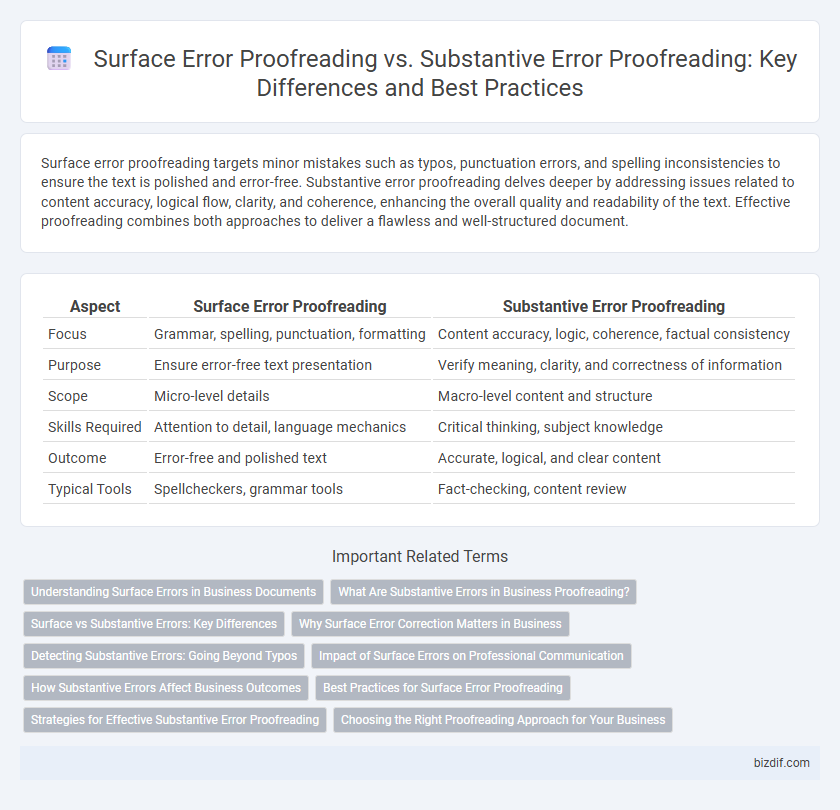Surface error proofreading targets minor mistakes such as typos, punctuation errors, and spelling inconsistencies to ensure the text is polished and error-free. Substantive error proofreading delves deeper by addressing issues related to content accuracy, logical flow, clarity, and coherence, enhancing the overall quality and readability of the text. Effective proofreading combines both approaches to deliver a flawless and well-structured document.
Table of Comparison
| Aspect | Surface Error Proofreading | Substantive Error Proofreading |
|---|---|---|
| Focus | Grammar, spelling, punctuation, formatting | Content accuracy, logic, coherence, factual consistency |
| Purpose | Ensure error-free text presentation | Verify meaning, clarity, and correctness of information |
| Scope | Micro-level details | Macro-level content and structure |
| Skills Required | Attention to detail, language mechanics | Critical thinking, subject knowledge |
| Outcome | Error-free and polished text | Accurate, logical, and clear content |
| Typical Tools | Spellcheckers, grammar tools | Fact-checking, content review |
Understanding Surface Errors in Business Documents
Surface errors in business documents primarily include spelling mistakes, punctuation errors, and formatting inconsistencies that affect the document's readability and professionalism. Identifying and correcting these surface errors ensure clarity and maintain the company's credibility, preventing misinterpretation by stakeholders. Unlike substantive error proofreading, which addresses content accuracy and logical flow, surface error proofreading focuses on polishing the text to meet standard language conventions.
What Are Substantive Errors in Business Proofreading?
Substantive errors in business proofreading refer to mistakes that affect the meaning, accuracy, or clarity of the document, such as incorrect data, inconsistent facts, or faulty logic. These errors can lead to misunderstandings, misinterpretations, and potentially costly business decisions. Addressing substantive errors involves thorough verification of content, ensuring logical flow, and confirming that all business information is precise and relevant.
Surface vs Substantive Errors: Key Differences
Surface error proofreading targets superficial mistakes such as spelling, punctuation, and grammar, ensuring basic text accuracy and readability. Substantive error proofreading addresses deeper issues involving content, logic, and consistency, aiming to improve clarity, coherence, and factual correctness. Distinguishing between surface and substantive errors is essential for effective proofreading strategies that enhance both linguistic precision and overall message integrity.
Why Surface Error Correction Matters in Business
Surface error proofreading targets spelling, grammar, and punctuation mistakes that directly affect clarity and professionalism in business documents. Correcting these errors enhances the company's credibility, prevents misunderstandings, and ensures clear communication with clients, stakeholders, and partners. Maintaining error-free content reflects attention to detail, reinforcing a positive brand image and supporting effective business operations.
Detecting Substantive Errors: Going Beyond Typos
Detecting substantive errors in proofreading requires analyzing content for logical consistency, factual accuracy, and clarity rather than merely correcting surface-level typos or formatting issues. Substantive error proofreading involves verifying information, evaluating argument coherence, and ensuring the text meets its intended purpose across academic, technical, or professional documents. This process enhances overall document quality by addressing hidden mistakes that simple surface error proofreading might overlook.
Impact of Surface Errors on Professional Communication
Surface error proofreading targets spelling, punctuation, and grammar mistakes that can undermine the credibility of professional documents. Even minor surface errors can distract readers, reduce clarity, and negatively affect the perceived professionalism of communication. Substantive error proofreading, by contrast, ensures accuracy in content and logical consistency, but neglecting surface errors poses a significant risk to the overall impression conveyed by the text.
How Substantive Errors Affect Business Outcomes
Substantive errors in proofreading, such as factual inaccuracies, logical inconsistencies, or omitted crucial information, significantly undermine business credibility and decision-making processes. These errors lead to misinterpretation of data, flawed strategies, and potential financial losses, impacting stakeholder trust and operational efficiency. Prioritizing substantive error proofreading ensures accuracy and clarity, directly influencing positive business outcomes and maintaining competitive advantage.
Best Practices for Surface Error Proofreading
Surface error proofreading demands meticulous attention to spelling, punctuation, and grammar to enhance the clarity and professionalism of the text. Best practices include reading the document aloud, utilizing digital tools like spell checkers combined with manual review, and taking breaks between proofreading sessions to maintain objectivity. Consistent application of style guides such as the Chicago Manual of Style or APA ensures uniformity in surface-level corrections.
Strategies for Effective Substantive Error Proofreading
Effective substantive error proofreading requires a deep understanding of the document's context, subject matter, and intended audience to identify and correct issues that affect meaning and clarity. Employing strategies such as reading aloud, checking for logical consistency, and cross-referencing facts ensures that arguments are coherent and information is accurate. Using specialized tools like content analysis software combined with manual review enhances the detection of nuanced semantic errors beyond surface-level spelling and grammar mistakes.
Choosing the Right Proofreading Approach for Your Business
Surface error proofreading targets grammar, punctuation, and spelling mistakes to ensure text clarity and professionalism, making it ideal for marketing materials and customer communication. Substantive error proofreading involves deeper content review, correcting logical inconsistencies, factual errors, and structural issues, which benefits technical documents and academic papers. Selecting the right proofreading approach depends on the document type, audience, and the level of accuracy required to maintain brand reputation and credibility.
Surface Error Proofreading vs Substantive Error Proofreading Infographic

 bizdif.com
bizdif.com